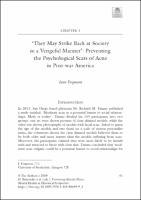Chapter 3 ‘They May Strike Back at Society in a Vengeful Manner’
Preventing the Psychological Scars of Acne in Post-war America
| dc.contributor.author | Ferguson, Iain | |
| dc.date.accessioned | 2021-04-26T11:47:08Z | |
| dc.date.available | 2021-04-26T11:47:08Z | |
| dc.date.issued | 2019 | |
| dc.identifier.uri | https://library.oapen.org/handle/20.500.12657/48388 | |
| dc.language | English | en_US |
| dc.subject.classification | thema EDItEUR::J Society and Social Sciences::JM Psychology | en_US |
| dc.subject.other | acne; psychological scars; Post-war America | en_US |
| dc.title | Chapter 3 ‘They May Strike Back at Society in a Vengeful Manner’ | en_US |
| dc.title.alternative | Preventing the Psychological Scars of Acne in Post-war America | en_US |
| dc.type | chapter | |
| oapen.abstract.otherlanguage | Following the Second World War, adolescent medicine emerged in the United States as a speciality focussed on addressing the physical, social and psychological problems of teenagers. While acne had been thought of as an inevitable consequence of maturation, the focus on teen health transformed the condition into a high priority. In particular, a deluge of medical studies raised concerns over the potentially serious psychological implications for teenage acne sufferers. Seeking to lessen the emotional impact of the condition, health professionals employed treatments such as tranquillisers commonly used for treating psychiatric patients, surgical techniques to minimise scarring and alternative therapies like hypnotherapy. The chapter argues that adolescent acne was not only constructed as a threat to the emotional well-being of teenage Americans (and thus the social order of the United States), but was also portrayed as an ailment which had to be overcome at all costs. | en_US |
| oapen.relation.isPublishedBy | 6c6992af-b843-4f46-859c-f6e9998e40d5 | en_US |
| oapen.relation.isPartOfBook | 7774e71c-5c92-4362-8589-1cb030290f89 | en_US |
| oapen.relation.isFundedBy | d859fbd3-d884-4090-a0ec-baf821c9abfd | en_US |
| oapen.collection | Wellcome | en_US |
| oapen.imprint | Palgrave Macmillan | |
| oapen.pages | 25 | en_US |
| oapen.grant.number | 10858/Z/15/Z |

